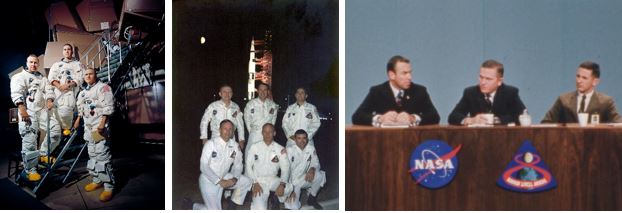With just two weeks to go before their historic launch to the Moon, Apollo 8 astronauts Frank Borman, James A. Lovell, and William A. Anders were spending much of their time at Kennedy Space Center (KSC), rehearsing various aspects of their upcoming mission in the flight simulators and reviewing procedures. All preparations were on schedule for the Dec. 21, 1968, liftoff of the first human mission to orbit the Moon. In a press conference Dec. 7 at the Manned Spacecraft Center, now the Johnson Space Center in Houston, Borman summed up the crew’s readiness, “I think we can say we’re ready two weeks before” the flight.
Preparations for the following two flights, Apollo 9 and 10, were also continuing. Apollo 9, planned for late February 1969, was the first crewed test of the Lunar Module (LM) in Earth orbit and included the first and only Apollo spacewalk before the Moon landing. Tentatively scheduled for May, Apollo 10 was a dress rehearsal of the landing mission, with the LM descending to within 50,000 feet of the Moon’s surface before returning to the waiting Command and Service Module (CSM) in lunar orbit.

CDDT underway, the Apollo 8 crews pose in front of their Saturn V rocket at Launch Pad 39A – (front row, left to right)
backup crew of Neil Armstrong, Edwin “Buzz” Aldrin, and Fred Haise; (back row, left to right) prime crew of Borman,
Lovell, and Anders. Right: Apollo 8 crew (left to right) Lovell, Borman, and Anders during a press conference at MSC.
The Apollo 8 Countdown Demonstration Test (CDDT) was completed at KSC between Dec. 5 and 11, and consisted of “wet” and “dry” phases. In the first wet phase, the entire countdown was simulated, including the loading of propellant in the rocket’s three stages, down to T minus 8.9 seconds, the time in the countdown when the first stage’s five F-1 engines ignite. For safety reasons, the crew did not participate in the wet countdown. At the end of the wet phase, the fuel was drained from the rocket and the countdown recycled. The next day, the countdown again proceeded to the point of first stage ignition, but for this dry phase the crew was suited up and strapped into the capsule as they would be on launch day. The CDDT also tied in the Mission Control Center at MSC, and the Manned Space Flight Network, a series of tracking stations around the world used to monitor all aspects of the mission. The CDDT was the last major test before the countdown for flight began on Dec. 15.
Although much focus was on the near-term Apollo 8 flight, preparations also continued for the next two missions. In KSC’s Manned Spacecraft Operations Building (MSOB), on Nov. 30 workers installed the Apollo 9 LM in its Spacecraft LM Adapter (SLA) and then stacked the CSM on top. They transferred that assembly to the VAB three days later and where engineers stacked it atop the already assembled Saturn V rocket. Rollout to Launch Pad 39A, at the time still occupied by Apollo 8, occurred early in 1969. Also in the VAB, by Dec. 7 workers had stacked the first two stages of the Saturn V for Apollo 10, while in the MSOB altitude chamber engineers performed a docking test of the Apollo 10 CSM and LM on Dec. 11.

the VAB on Dec. 3, 1968. Middle: The Apollo 9 CSM/SLA being hoisted to be mated to the Saturn V in the VAB, with the
folded legs of the LM visible at the bottom. Right: Docking test of the Apollo 10 CM (bottom) and LM (top) in the
MSOB altitude chamber.

























